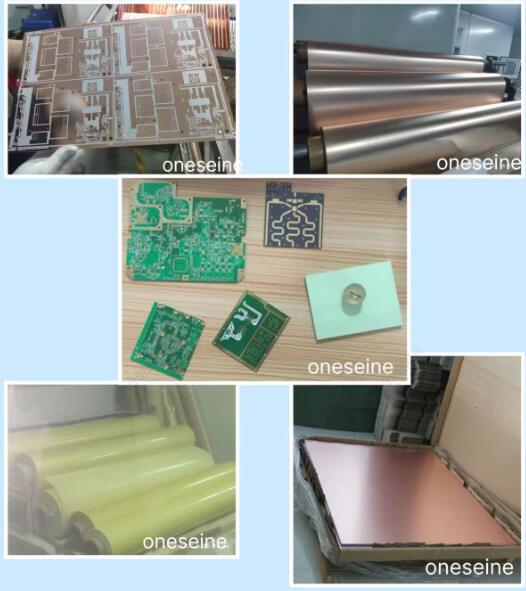ONESEINE TECHNOLOGY CO.,LTD |
|
Verified Suppliers
|
|
2 Layer GSM Antenna pcb Circuit Board Design High Frequency RT Duroid 5880 PCB Substrate
2 Layer GSM pcb Circuit Board Design High Frequency RT Duroid 5880 PCB Substrate
PCB details:
Product name: 2 Layer Antenna Circuit Board High Frequency RT Duroid 5880 PCB Substrate
Brand Name:ONESEINE
Base Material:Rogers5880
Copper Thickness:1OZ
Board Thickness:0.8mm
Min. Hole Size:0.2mm
Min. Line Width:4mil
Min. Line Spacing:4mil
Surface Finishing:ENIG
Certificate:RoSH ISO9001 UL
Board Thickness Tolerance:+/-10%
Hole tolerance:PTH: +/-3mil NPTH: +/-2mi
Min distance pad-pad:8mil
Min distance trace-pad:8mil
Min distance trace-via:4mil
PCB Standard:IPC-A-610 D
Shipping:DHL UPS TNT Fedex
Inner Package:Vacuum package
High frequency PCB range:
Frequency Range: High-frequency PCBs are designed to operate in frequency ranges typically starting from a few megahertz (MHz) and extending into the gigahertz (GHz) and terahertz (THz) ranges. These PCBs are commonly used in applications such as wireless communication systems (e.g., cellular networks, Wi-Fi, Bluetooth), radar systems, satellite communication, and high-speed data transmission.
Signal Loss and Dispersion: At high frequencies, signal loss and dispersion become significant concerns. High-frequency PCBs employ techniques to minimize these effects, such as using low-loss dielectric materials, controlled impedance routing, and minimizing the length and number of vias.
PCB Stackup: The stackup configuration of a high-frequency PCB is carefully designed to address signal integrity requirements. It typically consists of multiple layers of copper traces, dielectric materials, and ground planes. The arrangement of these layers is optimized to control impedance, minimize crosstalk, and provide shielding.
RF Connectors: High-frequency PCBs often incorporate specialized RF connectors to ensure proper signal transmission and minimize losses. These connectors are designed to maintain consistent impedance and minimize reflections.
Electromagnetic Compatibility (EMC): High-frequency PCBs must comply with electromagnetic compatibility standards to prevent interference with other electronic devices and to avoid susceptibility to external interference. Proper grounding, shielding, and filtering techniques are employed to address EMC requirements.
Simulation and Analysis: Designing high-frequency PCBs often involves simulation and analysis using specialized software tools. These tools allow designers to assess signal integrity, impedance matching, and electromagnetic behavior before fabrication, helping to optimize the PCB design for high-frequency performance.
Fabrication Challenges: Fabricating high-frequency PCBs can be more challenging compared to standard PCBs. The use of specialized materials, controlled impedance requirements, and tight tolerances require advanced fabrication techniques such as accurate etching, controlled dielectric thickness, and precise drilling and plating processes.
Testing and Validation: High-frequency PCBs undergo rigorous testing and validation to ensure their performance meets the desired specifications. This includes impedance testing, signal integrity analysis, insertion loss measurement, and other RF and microwave tests.
It's important to note that the design and manufacturing of high-frequency PCBs are specialized areas requiring expertise in RF and microwave engineering, PCB layout, and fabrication processes. Working with experienced professionals and consulting relevant design guidelines and standards is crucial to ensure reliable performance at high frequencies.
High frequency PCB description:
High frequency PCB material in stock:
Brand | Model | Thickness(mm) | DK(ER) |
Rogers | RO4003C | 0.203mm,0.305mm,0.406mm,0.508mm,0.813mm,1.524mm | 3.38 ± 0.05 |
RO4350B | 0.101mm,0.168mm,0.254mm,0.338mm,0.422mm,0.508mm,0.762mm,1.524mm | 3.48 ± 0.05 | |
RO4360G2 | 0.203mm,0.305mm,0.406mm,0.508mm,0.610mm,0.813mm,1.524mm | 6.15 ± 0.15 | |
RO4835 | 0.168mm,0.254mm,0.338mm,0.422mm,0.508mm,0.591mm, 0.676mm,0.762mm,1.524mm | 3.48 ± 0.05 | |
RT5870 | 0.127mm,0.787mm,0.254mm,1.575mm,0.381mm,3.175mm,0.508mm | 2.33 | |
RT5880 | 0.127mm,0.787mm,0.254mm,1.575mm,0.381mm,3.175mm,0.508mm | 2.20 | |
RO3003 | 0.13mm,0.25mm,0.50mm,0.75mm,1.52mm | 3.00 ±0.04 | |
RO3010 | 0.13mm,0.25mm,0.64mm,1.28mm | 10.2 ± 0.30 | |
RO3006 | 0.13mm,0.25mm,0.64mm,1.28mm | 6.15 ± 0.15 | |
RO3203 | 0.25mm,0.50mm,0.75mm,1.52mm | 3.02±0.04 | |
RO3210 | 0.64mm,1.28mm | 10.2±0.50 | |
RO3206 | 0.64mm,1.28mm | 6.15±0.15 | |
R03035 | 0.13mm,0.25mm,0.50mm,0.75mm,1.52mm | 3.50 ± 0.05 | |
RT6002 | 0.127mm,0.254mm,0.508mm,0.762mm,1.524mm,3.048mm | 2.94 ± 0.04 | |
RT6006 | 0.127mm,0.254mm,0.635mm,1.27mm,1.90mm,2.50mm | 6.15± 0.15 | |
RT6010 | 0.127mm,0.254mm,0.635mm,1.27mm,1.90mm,2.50mm | 10.2 ± 0.25 | |
TACONIC | TLX-8.TLX-9 | 0.508. 0.762 | 2.45-2.65 |
TLC-32 | 0.254,0.508,0.762 | 3.35 | |
TLY-5 | 0.254,0.508.0.8, | 2.2 | |
RF-60A | 0.254.0.508.0.762 | 6.15 | |
CER-10 | 0.254.0.508.0.762 | 10 | |
RF-30 | 0.254.0.508.0.762 | 3 | |
TLA-35 | 0.8 | 3.2 | |
ARLON | AD255C06099C | 1.5 | 2.55 |
MCG0300CG | 0.8 | 3.7 | |
AD0300C | 0.8 | 3 | |
AD255C03099C | 0.8 | 2.55 | |
AD255C04099C | 1 | 2.55 | |
DLC220 | 1 | 2.2 |
